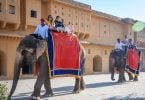The Edinburgh Dungeon said the one-day event is in revenge for the Battle of Falkirk, fought 710 years ago July 21st, at which more than 2,000 Scots were slaughtered by the Auld Enemy.
English visitors will only be allowed entry if they sign a scroll swearing allegiance to Scotland, while those from other countries will be encouraged to bring in items deemed ‘typically English’ to be smashed.
The attraction, which is visited by 200,000 people per year insisted the measures were a fitting tribute to the Scots soldiers who were killed and their leader, William Wallace.
But it faces a growing backlash from English tourists appalled that they were being singled out for something that happened so long ago.
Victoria Price, 26, from Manchester, currently holidaying in Edinburgh, said: “I was planning to visit the Dungeon because I had heard it was fun. But I wouldn’t give them my money now.
“The Battle of Falkirk was more than 700 years ago for Heaven’s sake. It should be put in the past, but it seems some people find that very hard.”
King Edward I, known as the Hammer of the Scots, decided to crush them in revenge for Wallace’s victory at Stirling Bridge in 1297 and assembled a massive army of more than 20,000 men.
In the battle, on July 22 1298, Wallace’s army of only around 6,000 men was destroyed by Edward’s longbows, although at the cost of almost 2,000 English casualties.
The attraction has a feature about Wallace, in which a ghost of the legendary Scots leader urges Scots to fight on against the invading “tyrannical” English.
Played by John Smeaton, one of the heroes who prevented last year’s terror attack at Glasgow Airport, he tells how thousands of Scottish soldiers were massacred.
Ian Scouller, the Dungeon’s manager, said: “People, not just from Scotland but from all over the world, said we should do something to commemorate that battle and get a bit of revenge.
“One visitor said we should mark the day by banning the English. We welcome more than 600 visitors every day. Many of them are English, and I expect we will take a hit in the pocket.”
But he claimed that Wallace and the Scots soldiers who fell that day would approve, adding: “The only way the English will be allowed in is if they sign a scroll pledging allegiance to Scotland – the kind of thing Edward I routinely did to Scots.”
Mr Scouller, a Glaswegian, also detailed another way for Scots to “gain revenge”.
He said: “People are invited to bring scones, tea bags, English literature, fine bone china or anything else typically English. We plan to smash them with a sword like the one Wallace carried.”
David Ross, Convener of the Society of William Wallace, described the ban on English visitors as “comical” and praised the Dungeon for marking the battle.
He added: “I’m sure it is meant tongue in cheek, but the English did far worse things to the Scots in Wallace’s time.”
The Edinburgh Dungeon is one of Edinburgh’s five most popular tourist attractions and is part of a chain, with other branches in London, York, Hamburg and Amsterdam.
In addition to its Wallace feature, exhibits include a torture chamber with thumb-screws, flesh tearers and head crushers, once used in Scotland to punish criminals.
Visitors also hear tales of some of Scotland’s most macabre criminals including notorious body snatchers Burke and Hare and cannibal Sawney Bean.
telegraph.co.uk





















